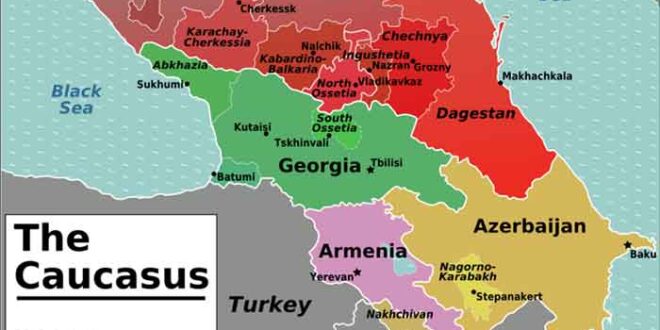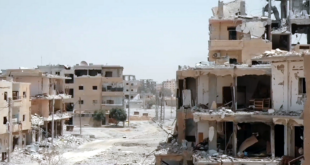President Putin has been making some astonishing demands, including:
NATO mustn’t admit additional countries near Russia, such as Ukraine and Georgia.
NATO must cease military activity in non-NATO territories: Georgia, Ukraine, the Caucasus, Central Asia, and parts of eastern Europe.Yet, incredibly, Putin has himself been enabling a NATO member’s aggression bordering Russia.
In 2020, the Kremlin embraced Turkey’s sending American-designed/equipped F-16s and Bayraktar drones containing NATO components into Azerbaijan.
Turkey and Azerbaijan (“one nation, two states”) subsequently defeated the Armenian populated Artsakh Republic/Nagorno-Karabagh and Russia’s longtime ally, Armenia. Israel backed Azerbaijan militarily.
The brutal 44-day war ended with a so-called peace agreement on November 9, 2020.
Russia facilitated Turkey’s (and, de facto, NATO’s) participation in Putin’s self-defeating grudge war against Armenians:
Putin stood aside as Turkey openly deployed troops, weapons, and thousands of Russian-hating international terrorists into Azerbaijan.
Turkey and Azerbaijan struck parts of Armenia, not just Artsakh. Yet Russia and the Russian-led CSTO (Collective Security Treaty Organization) patently ignored their defense pacts with Armenia.
For decades, Russia had stopped battles over Artsakh between Azerbaijan and Armenians at an early stage despite Artsakh’s lacking a defense treaty with Russia. This time, though, Moscow intervened only belatedly (November 2020) as it posted Russian “peacekeeping” troops in parts of Artsakh.
Moscow welcomed Turkish soldiers to partner with Russians in “monitoring” the peace agreement.
Since the war ended, Putin and the CSTO (Azerbaijan isn’t a member) have shamelessly humiliated their Armenian ally. For instance, Russia is permitting Azeri troops — unquestionably at Turkey’s urging — to invade southern Armenia, seize highways, kill civilians, and attack Armenia’s diminished military.
Russia and the CSTO continue to rebuff Yerevan’s legitimate requests for assistance.In contrast:
In January, Putin promptly dispatched CSTO troops into member Kazakhstan to subdue violent protests.
NATO never signed a formal agreement barring eastward expansion. Therefore, despite the Kremlin’s contention, NATO isn’t legally required to bar Ukraine’s possible membership. Russia and the CSTO are, however, legally required to adhere to their signed, formal defense pacts with Armenia but aren’t doing so.Russia’s Angry President
Elected on an anti-corruption platform in 2018’s democratic “Velvet Revolution,” Armenian Prime Minister Nikol Pashinyan was reelected in 2021.
Russia dislikes democratic leaders. They’re harder to arm-twist and bribe. True, Pashinyan has been somewhat friendlier to Western nations than Armenia’s earlier leaders.
Yet, post-independence (1991), Yerevan has maintained excellent political and economic relations with the EU, U.S., and NATO. In 2005, America built one of its largest embassies in the world under President Robert Kocharyan, a Putin favorite.
Regardless, Putin hated Pashinyan, barely spoke to him, and never gave him a chance.
European–Armenian relations go back thousands of years. A strong U.S.–Armenian friendship dates to the 19th century. This is natural for an ancient Christian nation speaking an Indo-European tongue.
Armenia has, nevertheless, allied itself with Russia for historical reasons and as security against genocidal Turkey and Azerbaijan. A more reliable Russian ally doesn’t exist.
Yerevan and Pashinyan certainly made mistakes before and during the war. But Putin’s angry betrayal of Armenians has been undeserved and irrational.
Pashinyan never oriented Yerevan away from Moscow. He couldn’t.
Moscow’s Grip
Russia supplies nearly all its ally’s gas, oil, and weapons, controls much of its energy infrastructure, including the Metsamor nuclear power plant, and has two military bases in Armenia.
The Kremlin’s imperialist attitude towards small allies: ‘You wouldn’t exist if not for Russia, so be eternally grateful. Otherwise, we’ll punish you even if it severely damages Russia.’
Indeed, due to Putin’s grudge war against Armenians:
Turkey and NATO are now embedded deeper than ever in Azerbaijan and the Caucasus — militarily, politically, and economically.
Russia’s foremost ally lost.No wonder the neo-con U.S. State Department’s and NATO’s condemnations of Turkish/Azerbaijani aggression have been generally low-key.
True, Russia may now have more control over Armenia and has deployed 2000 troops in Artsakh. But Russia could have gotten these without the war. Instead, the Kremlin chose anger and war over sound judgment.
Ironically, though livid at Pashinyan’s mild Western outreach, Moscow seems fine with Turkey’s Western military, economic, and political memberships: NATO, EU Customs Union, and scores more.
Similarly for Azerbaijan: The UK has invested $100 billion, the EU is a major trade partner, and American investment is massive.
Western money helped build Azerbaijani energy pipelines which avoided Russia, going instead through Moscow’s adversary, Georgia. Even Donald Trump attempted to build a $200 million hotel in Baku.
But no, Moscow prefers to bully and betray its best ally.
Is Armenia really an important ally?
The Turkish/NATO Threat to Russia
Were Armenia to somehow exit Moscow’s camp, Turkey and NATO would rapidly displace Russia from the Caucasus because:
Azerbaijan, a Western source for gas and oil, has long sided with Turkey not
Georgia is supported by the West, links Turkey and Azerbaijan, and is, in effect, a NATO candidate.The Caspian would become a NATO/Turkic lake.
Moreover, Kazakhstan, Turkmenistan, and Turkey’s pan-Turkic aspirations lie just across the Caspian.
Russia would face a future grimmer than what NATO in Europe poses.
Is Russia Reliable?
Besides Moscow’s recent treachery, Armenians remember Moscow’s gifting Artsakh, Nakhichevan, and Western Armenian territory to Azerbaijan and Turkey in the 1920s,
Russia’s growing weakness also makes Armenians question its reliability.
Russia has lost most of eastern Europe to NATO. Despite territorial gains in Ukraine and Georgia, Moscow may eventually lose them (and Belarus) unless it invades some or all of them, which is possible but risky.
Central Asia looks shaky due to Turkish, Western, and Chinese inroads.
Without allies in the Black Sea, Russia worries about NATO exercises such as Sea Breeze 2021.
Turkey poses other problems for Russia.
Over Putin’s protests, Turkey sells Bayraktars and other weapons to Ukraine. Ankara demands that Crimea be returned to Kyiv. President Erdogan has threatened Russia with a Muslim uprising and declared that Turkey is ascendant in Central Asia. Russia still can’t oust Turkey from Syria.
Influenced by Russia’s Eurasianist theorist Aleksandr Dugin, Putin thinks he’s luring Turkey away from NATO. Erdogan is unlikely to fall for that trap.
Armenia’s Dilemma
Suppose Yerevan could escape the Russian bear’s grip. Joining NATO would not guarantee its security. Turkey, which has murderous plans for Armenia, would vastly outweigh it.
Turkey threatens Greece, Cyprus, and others, invades whatever countries it pleases, and supports ISIS and other international terrorists while the U.S., NATO, and Europe look the other way.
Kowtowing to Turkey for 100+ years has destroyed the West’s credibility.
The Caucasus’s future is hard to predict, but some major things – unlikely as they seem now – could reshape the region in the medium and long terms.
To create a permanent Caucasus base, Russia may strong-arm Armenia into the Russian Federation and even, perhaps, make it Russia itself.
Russia – enchanted by Eurasianism – could sell Armenia to Turkey and Azerbaijan in pursuit of a Russo-Turko alliance.
At great political cost, Russia could shut down the entire NATO/Turkish eastward adventure by invading Georgia and Ukraine.As for Armenia, it must maneuver between the region’s competing powers as it has for 3000 years.
 Eurasia Press & News
Eurasia Press & News




